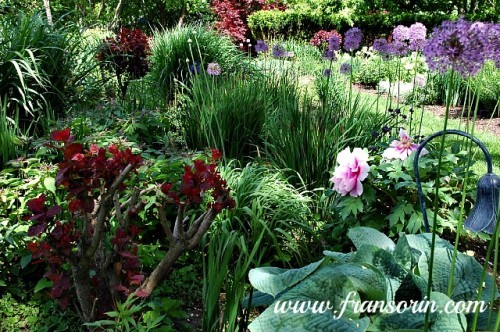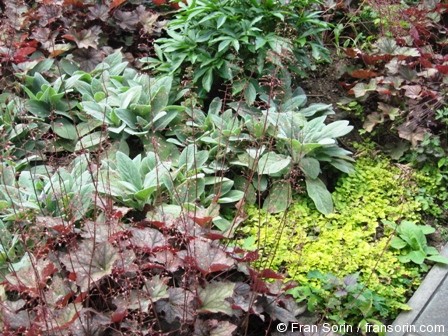What is it about perennials that cause gardeners to rhapsodize?
Their benefits are plentiful – they save money, time, and offer interesting texture, color, and shapes in our gardens.
But something deeper takes place when we nestle these living things into the soil – our collective unconscious connects with nature, helping us understand why we were placed on this Earth.
By observing the life cycle of these plants — blooming, thriving, wilting, and ‘dying’, only to be reborn the next year — we’re able to put some order and meaning into our own lives. Planting perennials lets us experience a feeling of optimism and a sense that we believe in the future.
When warmer weather surprises us in February and early March, we witness our spring bulbs and perennials peeking through the earth at least a month earlier than usual. Like an audience at a fashion show, we ‘ooh’ and ‘ahh’ at every new specimen that erupts from the ground. With a combination of pleasure and relief, we welcome back our old friends from what feels like endless months of separation. We’re delighted to see – most of the time- that through the process of self seeding they’ve added some new members to their tribe – as well as having grown themselves.
We have a unique relationship with our perennials. In a very real sense, our lives as gardeners inadvertently become intertwined with them. Most of us will be able to tell you what year and where we purchased a specific one – much like talking about the birth of our children. But some of us take it one step further. We can even tell you precisely what was going on in our lives at the time when we first ‘met’ this little being. Like a doting parent, if you let us, we can ramble on about all of its beauty, growth and ability to triumph in the face of adversity.
Over the years to come, we try to give our little pals a good foundation from which to grow and multiply. We feed and water them, observe their growth with joy, cajole them into blooming, and take care of them when sick or diseased.
And much like a parent, we offer them discipline. When they become unruly, we cut back, divide, and deadhead to maintain their health and vigor – so they can parade their glorious blooms for the longest time possible. Similar to our children, we marvel at them throughout all of their stages of growth. Ultimately, we accept and love them with all of their strengths and weaknesses.
In a world where too little story telling takes place, each of these plants offers a unique story that can be passed on from generation to generation. They may involve friends who have given us cuttings or visits with gardeners in far away places who share a harvest of special seed from their garden that we have so admired.
Although perennials are beautiful jewels, their ultimate power is revealed in how deeply they affect our spirit and actions. They soften our hearts and facilitate us in making generous connections with others. In a world that hungers for optimism, joyfulness, and kindness, these little plants teach us about all of those things and more. They act as a beacon of light – helping us stay grounded and have faith in goodness, beauty, generosity, and the never ending cycle of life.
Because of their presence in our lives, we have the potential to tread on this earth with a bit more grace.



Fran,
I love this because I am so excited for this spring. My poor perennials have a tough time last summer with out drought here. I have some flowers that are from the house I grew up in and will take to our next home where ever that may be. Our perennials are just like the people in our lives – when cared for and taken care of daily. They will be in our lives for a long time!
xoxo
Betsy
Betsy – Having survived several droughts on the East Coast – and now that i live in a Mediterranean climate – I’ve learned to take the importance of limiting my selections of plants to ‘drought resistant’.
Plants are our friends ~ they are so nurturing and are at our side in times of sadness, joy- the whole gamut of emotions.
I’ve just cut back my perennial grasses and am waiting for spring bulbs to begin to show their face. How I love Spring! Great to see you here. 🙂 Fran
I have some Hostas that have been growing in a front planter and pot, and it is so wonderful to see them come through each year as we wind into spring. Those and my Iceberg roses are my favorite perennials. Flowers do make me smile and they nurture my soul. Thanks for a beautiful post, Fran!
Cathy – I was just thinking of how much I love seeing hostas’ crowns burst through the spring soil. I’m a huge fan of roses so I understand why your Icebergs are favorites. It makes perfect sense and is magical that flowers bring a smile to our face. Research has shown with depressed and sick people that flowers help them significantly. Fran
You remind me Fran of all the many reasons I love flowers – not just because I come from a country where even the tiniest of gardens has flowers galore – but because they make me smile when I see them. It feels good to look at them wafting in the breeze.
Used to be I couldn’t wait for spring, so no surprise that daffodils were always my favourite flower along with snowdrops…anything that would turn grey old winter into a more beautiful place.
Aaah just reading your post this morning makes me smile. Thank you.
Love Elle
xoxo
Elle – The first time i went to england with a ‘gardener’s eye’, I was overwhelmed by the beauty of front yard gardens – no matter the location or the size.
There are several studies that have been done on the effect of plants and flowers on humans. I don’t need to tell you the results ~ happiness is the operative word. My bulbs are just beginning to break ground, I am finishing my seed list and am in the midst of planning a urban rooftop farm (in a quite small space). My energy shifts to a much higher level when the beautiful weather makes its entrance. 🙂 Fran
Indeed we tread a little more softly, with a little more compassion when we are in touch with the earth’s beauty. What a beautiful post, Fran. I have the pleasure walking around a lake near our place every day – I currently miss it because I am grounded from my recent accident. Luckily I have loads of pictures to look at and look forward to meeting them again. 🙂 Thank you for the treat. Hugs, Vidya
Vidya – I know that you’re passionate about nature and that all of your magnificent photos will keep you going until you’re healed. 🙂 Fran
Fran:
As a very young child, I took whatever seeds I could find at home (navy beans, tomatoes, etc.) and planted them. The fact that I could make something grow was so powerful I now have an extensive garden and all five of my children are plant lovers. One of them has a career in horticulture. It’s important to teach children the power of a seed. They never forget it.
Shirley-
How powerful and beautiful. Your story is proof that all it takes is to start with a seed of passion, let it germinate, grow …and many years later look back, smile, and think ‘this is what life is all about!’
Thanks so much for sharing. Warmly, Fran
I had to laugh when I read this because it reminded me of my favorite little pansies in my side yard. Now pansies are like weeds–easy to grow. But somehow I manage to kill them every time I try to brighten up a little corner. Several years ago, I planted some in my side yard near the chain link fence between me and my neighbors. Sure enough, they died. But then guess what. They started growing just on the other side of the fence! So now every year, they sprout up and tease me from the neighbors’ yard. You gotta love pansies. They have a great sense of humor.
Galen – Thanks for sharing your sweet, humorous, and informative post.
It is natural to want to transplant and spread the beauty of flowers that you love. But the pansies winked at you – they are free spirited- don’t do well being transplanted- and I would guess self seeded on your neighbor’s side of the fence. A good reminder of who’s in charge 🙂 Fran